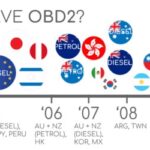Understanding your vehicle’s performance is crucial, whether you’re aiming for optimal fuel efficiency or enhanced power. Modern cars are equipped with sophisticated On-Board Diagnostics (OBD2) systems that monitor a vast array of sensors, providing valuable insights into your engine’s operation. For enthusiasts focused on performance driving and achieving perfect shifts, known as “Shift Obd2” optimization, these sensors are indispensable. Let’s explore the key sensors accessible through your OBD2 port and what they reveal about your car.
Essential OBD2 Sensors for Engine Monitoring
The OBD2 system offers a wealth of data points, allowing you to track everything from engine speed to exhaust gas composition. Here’s a breakdown of some of the most useful sensors:
Performance and Load Sensors
- Speed: Indicates the vehicle’s current speed. Essential for monitoring performance and ensuring accurate data logging.
- RPM (Revolutions Per Minute): Measures the engine crankshaft speed. Crucial for understanding engine load, shift points for optimal performance (“shift obd2”), and identifying potential engine issues.
- Engine Load: Represents the percentage of maximum engine power being used. Helps assess engine stress and efficiency under different driving conditions.
- Mass Air Flow (MAF): Measures the amount of air entering the engine. Vital for fuel mixture calculations and diagnosing air intake problems.
- Throttle Position: Indicates the position of the throttle plate. Reflects driver input and is important for understanding engine response and acceleration.
Temperature and Pressure Sensors
- Coolant Temperature: Monitors the engine coolant temperature. Crucial for preventing overheating and ensuring proper engine operation.
- Intake Air Temperature (IAT): Measures the temperature of the air entering the intake manifold. Affects air density and engine performance.
- Intake Manifold Pressure (MAP): Measures the pressure inside the intake manifold. Indicates engine load and vacuum.
- Barometric Pressure: Measures atmospheric pressure. Used for altitude compensation in engine management systems.
- Fuel Pressure: Monitors the pressure of the fuel delivered to the engine. Essential for proper fuel delivery and combustion.
Fuel Trim and Oxygen Sensors
- Short Term Fuel Trim (STFT) & Long Term Fuel Trim (LTFT) Bank 1 & Bank 2: These percentages indicate the adjustments the engine control unit (ECU) is making to the fuel mixture in real-time (STFT) and over time (LTFT). Essential for diagnosing fuel system issues and ensuring optimal air-fuel ratio.
- O2 Voltage Sensors (Bank 1 & Bank 2, Sensor 1-4): Oxygen sensors measure the amount of oxygen in the exhaust gas. Critical for monitoring catalytic converter efficiency and air-fuel ratio. Sensor 1 is typically pre-catalytic converter, while Sensor 2 is post-catalytic converter. The voltage readings reflect the richness or leanness of the mixture.
- WR (Wide Range) Lambda Ratio & Voltage/Current Sensors (O2 Sensor 1-8): Wide range oxygen sensors provide a more precise measurement of the air-fuel ratio over a broader range than traditional O2 sensors. These are increasingly common in modern vehicles and offer more detailed insights into combustion efficiency.
Exhaust and Emission Related Sensors
- Evaporative System Vapor Pressure: Monitors the pressure in the evaporative emissions control system. Helps detect leaks in the fuel vapor recovery system.
- Catalyst Temperature Sensors (B1 & B2, Sensor 1 & 2): Monitor the temperature of the catalytic converter. Important for ensuring proper catalytic converter operation and preventing overheating.
- EGR (Exhaust Gas Recirculation) Commanded & Error: Monitors the operation of the EGR system, which reduces NOx emissions by recirculating exhaust gas back into the intake manifold.
Other Important Sensors
- Timing Advance: Indicates the ignition timing advance. Crucial for engine performance and efficiency.
- Fuel Level Input: Indicates the fuel level in the tank.
- Control Module Voltage: Monitors the voltage supplied to the engine control module.
- Absolute Load Value: Another metric for engine load calculation.
- Fuel/Air Commanded Ratio: The target air-fuel ratio set by the ECU.
- Relative Throttle Position & Absolute Throttle Position (A-F): More detailed throttle position readings, potentially from redundant sensors for accuracy.
- Ambient Air Temperature: Measures the outside air temperature.
- Commanded Throttle Actuator: Indicates the desired throttle position commanded by the ECU.
- Ethanol Fuel %: For flex-fuel vehicles, this sensor indicates the percentage of ethanol in the fuel.
- Fuel Rail Pressure Absolute & Manifold & Diesel: More precise fuel pressure readings at different points in the fuel system, including diesel specific measurements.
- Relative Acc. Pedal Position: Indicates the position of the accelerator pedal.
- Hybrid Battery %: For hybrid vehicles, this indicates the charge level of the hybrid battery.
- Oil Temperature: Monitors the engine oil temperature. Important for engine lubrication and preventing overheating, especially under demanding conditions.
- Fuel Injection Timing & Fuel Rate: Detailed fuel injection parameters.
- Engine Torque: Calculated engine torque output.
- Fuel Economy: Real-time fuel economy calculations.
- Boost Pressure: For turbocharged or supercharged engines, this sensor measures the intake manifold pressure above atmospheric pressure, indicating boost levels.
Utilizing OBD2 Data for “Shift OBD2” and Performance Enhancement
By monitoring these OBD2 sensors, especially RPM, engine load, throttle position, and speed, drivers can gain a deeper understanding of their vehicle’s behavior during acceleration and gear changes. This data is invaluable for optimizing shift points for maximum acceleration or fuel efficiency, which is at the heart of “shift obd2” performance driving. Furthermore, logging and analyzing sensor data over time can help identify potential mechanical issues early on, ensuring your vehicle remains in top condition. Investing in an OBD2 scanner and familiarizing yourself with these sensors is a smart move for any car enthusiast or performance-minded driver.
